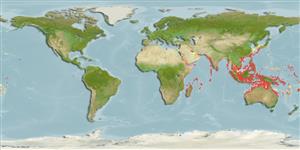Environment: milieu / climate zone / depth range / distribution range
Ecología
marino; salobre demersal; rango de profundidad 20 - 50 m (Ref. 28016). Tropical; 26°C - 29°C (Ref. 4959); 37°N - 27°S, 37°E - 170°W
Indo-West Pacific: Red Sea and East Africa to Samoa and Fiji, north to Japan, south to northeastern Australia.
Tamaño / Peso / Age
Maturity: Lm ? range ? - ? cm
Max length : 21.0 cm TL macho / no sexado; (Ref. 3424); common length : 17.0 cm TL macho / no sexado; (Ref. 3424)
Espinas dorsales (total) : 8; Radios blandos dorsales (total) : 16; Espinas anales: 3; Radios blandos anales: 14. Deep bodied and vertical dark bars on upper sides. Long filament on dorsal spine (Ref. 48635). Silvery body. Naked head; with nuchal spine. Protracted mouth pointing downward. Thin scales on breast. 2nd dorsal spine elongated.
Found in coastal waters. May also enter semi-enclosed sea areas and estuaries (Ref. 11230). Euryhaline (Ref. 12743). Forms schools (Ref. 30573). Feeds on polychaetes, small crustaceans, and small fish (Ref. 5213).
Life cycle and mating behavior
Maturities | Reproducción | Spawnings | Egg(s) | Fecundities | Larva
James, P.S.B.R., 1984. Leiognathidae. In W. Fischer and G. Bianchi (eds.) FAO species identification sheets for fishery purposes. Western Indian Ocean (Fishing Area 51). Vol. 2. FAO, Rome. pag. var. (Ref. 3424)
IUCN Red List Status (Ref. 130435)
Threat to humans
Harmless
Human uses
Pesquerías: escaso valor comercial
Herramientas
Special reports
Download XML
Fuentes de Internet
Estimates based on models
Preferred temperature (Ref.
123201): 24.2 - 28.7, mean 27.9 °C (based on 345 cells).
Phylogenetic diversity index (Ref.
82804): PD
50 = 1.0000 [Uniqueness, from 0.5 = low to 2.0 = high].
Bayesian length-weight: a=0.02138 (0.01632 - 0.02800), b=3.05 (2.97 - 3.13), in cm total length, based on LWR estimates for this species (Ref.
93245).
Nivel trófico (Ref.
69278): 3.4 ±0.39 se; based on food items.
Resiliencia (Ref.
120179): Alto, población duplicada en un tiempo mínimo inferior a 15 meses (Preliminary K or Fecundity.).
Fishing Vulnerability (Ref.
59153): Low vulnerability (11 of 100).
